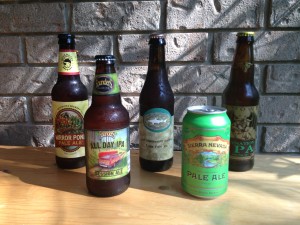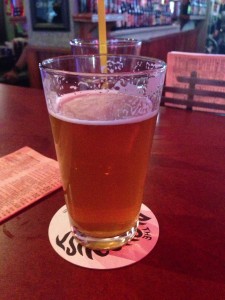This is the final installment of the American hoppy ales series, covering American pale ales, IPAs and double IPAs. Previous articles have discussed general water needs, the chloride to sulfate ratio, malt selection, wort production, suitable hop varieties, hopping during the boil, hopping outside of the boil and how much hops to add. There has also been a water treatment supplement and a primer on wort production using malt extract, as well as example recipes for an America pale ale, an American IPA and a double IPA clone.
The overall focus of brewing an American hoppy ale is to showcase the hops. So it’s no surprise that your approach to fermentation is to preserve as much of the hop character as possible. Overall, fermenting these ales differs little from fermenting any ale — there are just a few extra things to consider to go the final distance in pursuit of perfect hoppiness. At times, the differing requirements might seem to be at cross purposes, but keep in mind that the overarching goal is a healthy, ordered fermentation.
Yeast Strain
Use a clean ale strain for fermenting these beers. The “standard” clean American ale strain (or Chico strain, named because it reputedly derives from Sierra Nevada’s strain) is Wyeast 1056 (American Ale), White Labs WLP001 (California Ale) or Fermentis Safale US-05. Any of these, or any of the similar American ale yeast strains or blends will do a good job. British or Belgian ale yeasts will also work if you can manipulate the pitching rate, aeration level and fermentation temperature to obtain a “clean” fermentation — one that doesn’t lead to the production of a lot of fruity esters or other yeast-derived characteristics. Stay away from yeast strains that are described as yielding malty beers or enhancing the malt character of a beer.
Pitch Rate
As with any ale, you want to pitch enough yeast to achieve an orderly fermentation. However, as yeast remove bitterness from the wort as they ferment, you don’t want to pitch an excessive amount. Your best bet is to pitch anywhere between the optimal rate (for the beer’s starting gravity) and half that much. For any of these beers, a well-aerated 2-qt. (2-L) yeast starter is going to be in the right ballpark. (You might go a bit larger for the biggest double IPAs.)
Fermentation Temperatures
If you’ve ever smelled the airlock of a fermenting IPA, you’ve noticed a big hoppy aroma coming from it. Unfortunately, this means you are losing hop aroma during the fermentation. One way to lower the amount of hop aroma lost is to ferment in the lower part of your yeast’s recommended temperature range, to get a less vigorous fermentation. Don’t get carried away with this (especially if you purposely underpitched), because you still need a healthy fermentation to take place. However, if your IPA fermentations are usually extremely vigorous, reining them in a bit by dropping the fermentation temperature may help. And always keep in mind that hop aroma lost during fermentation can be compensated for by dry hopping.
Attenuation
In order to showcase the hops, you want your beer to finish at a reasonably low final gravity (FG). Obviously, your yeast strain should be highly attenuative (in the ballpark of Wyeast, 1056, White Labs WLP001 or Fermentis Safale US-05) and your wort should be produced to by highly fermentable. However, a healthy fermentation is still required to “seal the deal.” So, when thinking about your pitching rate and fermentation temperature, keep in mind you still want the fermentation to proceed in an orderly fashion and reach your target FG. If your yeast finish early — due to underpitching or the fermentation being too cool — all your previous efforts are lost. So, put the variables that slow the fermentation down to preserve bitterness or aroma in the context of still needing to achieve a vigorous, healthy fermentation.
Conditioning (and Avoiding Oxidation)
Oxidation kills hop aroma quickly. Once primary fermentation is done, your goal will be to get the beer packaged and expose it to as little oxygen as possible. Some things to help you achieve this goal are: 1.) Don’t rack the beer needlessly — if you can go from your primary fermenter to a keg, do so. (If you’re bottling, you may need to rack to secondary for dry hopping.) 2.) Don’t let dry hopping be an avenue for oxidation. Specifically, try to purge the air from between the bracts of the cones if using whole hops. 3.) Do not let these beers age excessively. If you ran a healthy fermentation, these ales should mature quickly, without the need for multiple weeks of conditioning time. The clock on the freshest hop character is ticking, so don’t down lay these beers down as if they were a barleywine. In a best case scenario, dry hop for a week then the beer condition for another week (maybe two if bottle conditioning). Then, start drinking.
American hoppy ales shouldn’t be overly fizzy, but they shouldn’t have the low level of carbonation typical of English ales, either. Anything in the 2.5 volumes of CO2 range is enough to bubble up the hop aroma to the beer drinker’s nose without turning the beer into burp fuel.
Serving
American hoppy ales, especially IPAs and dIPAs, may be a bit hazy due to being dry hopped — which adds tannins and other plant-derived molecules to the beer in addition to hop aroma. However, the hopping level should also stimulate a large foamy head. So when you pour the beer into a glass, let it splash enough to raise some foam and release some of the hop aroma you worked so hard to put there. If you think about, pull your beer out the fridge a few minutes before you open it — these ales open up a little bit when they aren’t ice cold. On the other hand, I don’t they get better when they move into the “cellar temperature” range (50–55 °F/10–13 °C) that British cask ales are traditionally served at.
I know its fashionable these days to mention pairing options when it comes to beer. (For example, “enjoy your smoked beer with an aged cheddar.”) So here is my pairing option opinion for American hoppy ales. Drink a hoppy beer . . . then drink an even hoppier beer. Cheers!



Awesome!
I’m just starting in this world of home-brewing and this ales hoppy series will help a lot in my first experiment. Thanks a lot!